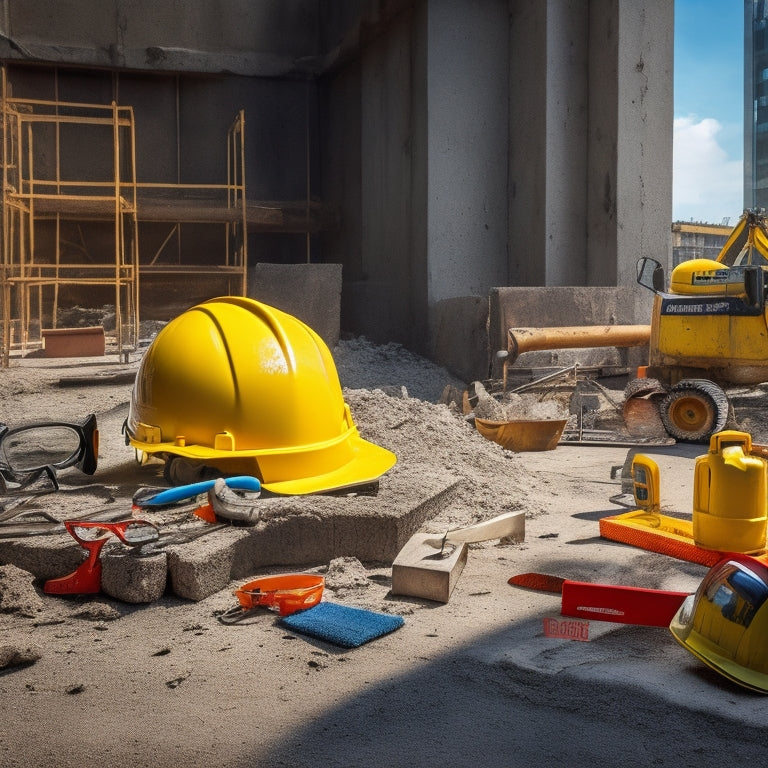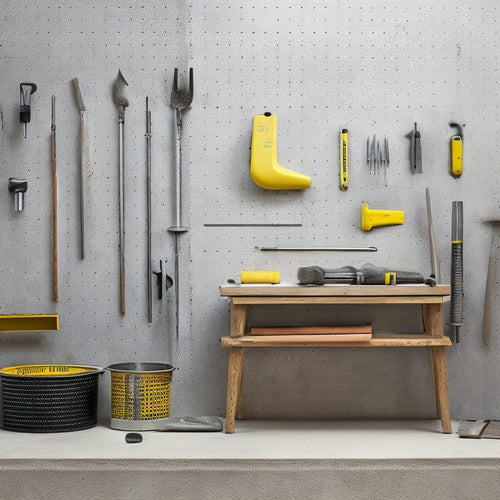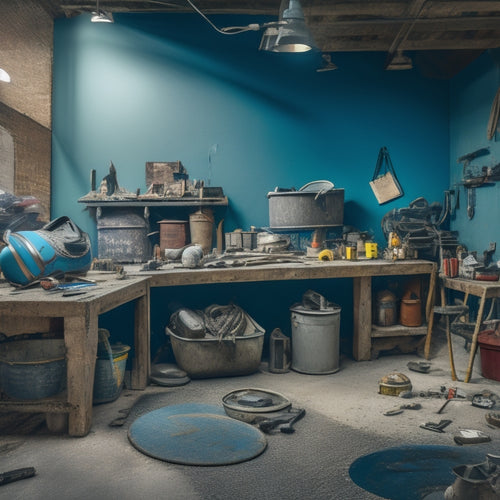
10 Must-Have Safety Tools for Concrete Construction
Share
You require a thorough array of safety tools to guarantee a safe working environment in concrete construction, where hazards like falling objects, sharp edges, and hazardous airborne particles are ever-present. You'll need a hard hat that meets ANSI Z89.1 standards, steel-toed boots with slip resistance, high-visibility vests that comply with ANSI/ISEA 107-2015 standards, gloves with textured palms and fingers, safety glasses with polycarbonate lenses, earplugs with a high noise reduction rating, respiratory masks rated for specific hazards, fall protection harnesses, first aid kits, and hazardous area signage. By understanding these essential safety tools, you'll be better equipped to protect yourself and your crew from the unique hazards of concrete construction, and explore the specific requirements for each tool to guarantee peak safety.
Key Takeaways
• Hard hats, steel-toed boots, and high-visibility vests are essential personal protective equipment for concrete construction workers.
• Safety glasses, earplugs, and respiratory masks protect workers from flying debris, loud machinery, and hazardous airborne particles.
• Fall protection harnesses and emergency preparedness kits, including first aid supplies and wound cleaning materials, are crucial for preventing injuries and fatalities.
• Respiratory masks must meet OSHA standards for dust protection and have a filter efficiency of at least 99.97% against particles as small as 0.3 microns.
• Hazardous area signage and regular safety training are vital for effective hazard communication and compliance with regulations.
Hard Hat Protection for Block Layers
You, as a block layer, must wear a hard hat that meets the American National Standards Institute (ANSI) Z89.1 standard, which specifies the minimum performance requirements for impact resistance, penetration resistance, and flammability. This essential head protection guarantees your safety on the construction site.
There are several hard hat types to choose from, each designed for specific job requirements. Type I hard hats provide top impact protection, while Type II hard hats offer both top and lateral impact protection. You may also opt for hard hats with additional features, such as ventilation systems or integrated eye protection.
When selecting a hard hat, consider the hazards present on your site, such as falling objects, electrical hazards, or chemical splashes. Look for hats with certification labels from reputable organizations, like ANSI or the Occupational Safety and Health Administration (OSHA).
Properly fitting and maintaining your hard hat is vital to its effectiveness. Regularly inspect your hard hat for signs of damage or wear, and replace it as needed.
Steel-Toed Boots for Hazardous Sites
When working on hazardous concrete construction sites, steel-toed boots are a must-have to protect your feet from heavy falling objects, sharp edges, and other potential hazards.
You need boots that can withstand the rigors of the job site, while also providing comfort and support throughout your shift. Look for boots with advanced materials and design features that prioritize boot comfort, such as breathable membranes, cushioned insoles, and ergonomic design.
Additionally, slip resistance is vital on concrete construction sites, where oil, water, and other substances can create hazardous conditions. Opt for boots with slip-resistant outsoles that provide traction on a variety of surfaces.
Don't compromise on safety – choose boots that meet or exceed industry standards for impact and compression resistance. Remember, your feet are your most valuable asset on the job site, and investing in high-quality steel-toed boots is essential for your protection and well-being.
High-Visibility Vests for Crew Safety
As you outfit your crew for concrete construction projects, you'll want to guarantee they're wearing high-visibility vests that meet strict safety standards.
You'll need vests that can enhance visibility in low-light conditions, such as dawn, dusk, or areas with limited lighting.
Enhance Visibility in Darkness
High-visibility vests with reflective strips and bright colors become essential gear for crew members working in low-light conditions, ensuring their visibility to operators of heavy machinery and vehicles.
As you work on a concrete construction site, you know that visibility is key to preventing accidents. That's why you need reflective clothing that meets or exceeds industry standards for visibility. Look for vests with reflective strips that are strategically placed to maximize visibility from multiple angles. Additionally, consider vests with bright colors that contrast with the surrounding environment, making you stand out even more.
In addition to high-visibility vests, portable lighting can also enhance your visibility in darkness. Portable lights can be attached to your vest or hard hat, providing an extra layer of visibility.
When choosing portable lighting, opt for lights that are durable, waterproof, and have adjustable brightness settings. By combining high-visibility vests with portable lighting, you'll be highly visible even in the darkest conditions, reducing the risk of accidents and ensuring a safe working environment.
Conform to Regulations Easily
You can guarantee compliance with industry regulations by selecting high-visibility vests that meet or exceed ANSI/ISEA 107-2015 standards for visibility, which dictate specific requirements for reflective materials, color, and design.
This guarantees that your crew's vests are easily visible in a variety of lighting conditions, reducing the risk of accidents and injuries.
By choosing vests that meet these standards, you can avoid costly fines and penalties associated with non-compliance.
Furthermore, regulatory compliance is essential during safety audits, where inspectors scrutinize your site's safety protocols and equipment.
With high-visibility vests that meet ANSI/ISEA standards, you can demonstrate your commitment to crew safety and regulatory compliance.
This not only enhances your reputation but also reduces the likelihood of work stoppages and project delays.
Gloves for Grip and Protection
Wearing gloves with textured palms and fingers provides a secure grip on tools and materials, even in wet or slippery conditions, while simultaneously protecting your hands from abrasions and punctures.
When working with concrete, it's crucial to have gloves that can withstand the demands of the job. Look for gloves made with cut resistant materials, such as Kevlar or Dyneema, to protect your hands from sharp objects and rough surfaces.
Some key features to take into account when selecting gloves for concrete construction include:
-
Ergonomic designs that fit comfortably and allow for dexterity, reducing fatigue and improving productivity
-
Reinforced palms and fingers for added protection
-
Breathable materials to keep your hands cool and dry
- Grip patterns on the palms and fingers to enhance traction and control
Safety Glasses for Debris Protection
As you move from handling concrete materials to operating power tools, your eyes become vulnerable to flying debris, making it essential to don safety glasses that provide thorough protection.
You can't afford to compromise on your vision, as even a minor injury can lead to long-term damage or blindness. That's why you need safety glasses that meet stringent eyewear standards, such as those set by the American National Standards Institute (ANSI).
Look for glasses with polycarbonate lenses that can withstand high-velocity impacts and offer 99.9% optical clarity. Additionally, consider glasses with anti-fog coatings and ventilation systems to prevent moisture buildup and guarantee clear visibility.
Regularly cleaning and maintaining your safety glasses is also vital for preventative maintenance. Make sure to wipe them down with a soft cloth and store them in a protective case when not in use.
Earplugs for Noise Reduction
Operating power tools and heavy machinery in concrete construction sites generates intense, ear-splitting noise that can cause permanent hearing damage or tinnitus if left unprotected. As a construction worker, you're at risk of noise-induced hearing loss, a serious condition that can greatly impact your quality of life. That's why earplugs are a must-have safety tool for concrete construction.
Here are some key benefits of using earplugs on the job site:
-
Prevents noise-induced hearing loss: Earplugs reduce the intensity of loud noises, protecting your hearing from permanent damage.
-
Improves communication: By reducing background noise, earplugs help you focus on conversations and instructions, improving communication with your team.
-
Enhances earplug effectiveness: Look for earplugs with a high noise reduction rating (NRR) to guarantee maximum protection.
- Increases comfort: Custom-fit earplugs can be designed to fit comfortably in your ears, reducing fatigue and discomfort during long work shifts.
Respiratory Masks for Dusty Environments
You breathe in hazardous airborne particles, including silica dust and cement, every time you cut, grind, or drill into concrete, making respiratory masks a vital safety tool for protecting your lungs in dusty environments.
Prolonged dust exposure can lead to serious respiratory issues, such as silicosis, and even lung cancer. That's why it's important to wear a respiratory mask that meets the Occupational Safety and Health Administration's (OSHA) standards for dust protection.
Look for masks with a filter efficiency of at least 99.97% against particles as small as 0.3 microns. The mask's effectiveness also depends on a proper fit, so guarantee a snug seal around your face.
You can opt for disposable masks or reusable ones with replaceable filters. Regardless of the type, it's necessary to maintain and inspect your mask regularly to confirm its effectiveness.
Fall Protection Harnesses for Elevated Work
When working at heights, such as on scaffolding, ladders, or roofs, fall protection harnesses are essential safety tools that can mean the difference between life and death in concrete construction. You must guarantee that you're properly equipped with a reliable harness that's designed for elevated work safety.
Here are some vital factors to take into account when selecting and using fall protection harnesses:
-
Harness inspection: Regularly inspect your harness for signs of wear, damage, or degradation. Look for frayed ropes, broken buckles, or rusty metal components.
-
Proper fitting: Ensure a snug and comfortable fit to prevent the harness from shifting during a fall. Make adjustments as needed to accommodate your body type and clothing.
-
Anchorage points: Identify secure anchorage points that can withstand the force of a fall. This could include sturdy beams, columns, or designated anchor points.
- Training and certification: Receive proper training on how to use your fall protection harness correctly, and obtain certification to demonstrate your competence.
First Aid Kits for Emergency Response
When responding to emergencies on a concrete construction site, you'll need a well-stocked first aid kit that's easily accessible.
You should guarantee it includes basic life support supplies, such as CPR masks and gloves, to help you provide immediate care.
Additionally, your kit should contain wound cleaning supplies, like antiseptic wipes and gauze, to help prevent infection and promote healing.
Basic Life Support
Concrete construction sites require a well-stocked first aid kit, strategically located for quick access, to provide immediate care for injured workers until medical professionals arrive.
As a site manager, you understand the importance of being prepared for emergencies. That's why you need to guarantee your first aid kit includes basic life support tools to respond to cardiac emergencies.
You should know how to perform CPR techniques, and your team should practice emergency drills regularly. In the event of a cardiac emergency, every minute counts, and having the right tools can make all the difference.
Make certain your first aid kit includes:
-
Automated External Defibrillators (AEDs) to restore a normal heartbeat
-
CPR masks to prevent disease transmission
-
First aid manuals with step-by-step CPR instructions
- A phone or two-way radio to quickly call for medical help
Wound Cleaning Supplies
You'll also want to guarantee your first aid kit is equipped with wound cleaning supplies to effectively treat cuts and lacerations, which are common injuries on concrete construction sites. This is vital, as prompt wound cleaning can greatly reduce the risk of infection and promote healing.
Your kit should include antiseptic wipes, which are designed to remove dirt, debris, and bacteria from wounds. These wipes should be gentle on skin while still providing effective disinfection.
Additionally, sterile dressings are essential for covering and protecting wounds. Look for dressings that are breathable, waterproof, and hypoallergenic to minimize irritation.
It's also a good idea to include gauze pads and rolls, which can be used to apply pressure and dress wounds.
Warning Signs for Hazardous Areas
As a concrete construction professional, you understand the importance of prioritizing safety on the job site. In areas where hazardous conditions exist, posting clear and concise warning signs is crucial to alert workers of potential dangers and prevent accidents.
Effective warning communication is critical to guaranteeing everyone's safety, and hazardous area signage plays an essential role in achieving this goal.
Here are some key considerations for warning signs in hazardous areas:
-
Sign design and layout: Confirm signs are easy to read and understand, with clear and concise language, and a layout that effectively communicates the hazard.
-
Sign placement: Strategically place signs in areas where they can be easily seen by workers, visitors, and emergency responders.
-
Sign durability: Choose signs that can withstand harsh environmental conditions, such as weather, dust, and chemicals.
- Sign compliance: Verify signs meet relevant regulations and standards, such as OSHA guidelines, to avoid fines and penalties.
Frequently Asked Questions
Can I Wear Regular Glasses Instead of Safety Glasses on Site?
You're wondering if regular glasses can replace safety glasses on site.
The short answer is no. While your prescription glasses may correct your vision, they don't meet vision protection regulations.
Safety glasses are specifically designed to withstand impact, providing critical protection for your eyes.
Don't risk your sight; opt for certified safety eyewear alternatives that meet industry standards, ensuring your eyes are safeguarded from hazards on the job site.
Are Hard Hats Required for All Concrete Construction Workers?
You might be surprised to learn that, according to OSHA, a staggering 2,200 construction workers suffer from head injuries every year.
When it comes to hard hats, you're not off the hook: OSHA's hard hat standards dictate that all concrete construction workers wear a hard hat that meets ANSI Z89.1-2014 standards.
It's not optional - safety regulations require hard hats to protect against falling objects, debris, and electrical hazards.
Can I Reuse Earplugs or Do I Need New Ones Daily?
When it comes to earplugs, you're right to wonder if reuse is an option. The answer is, it depends.
While disposable earplugs are convenient, reusable options are available. However, earplug hygiene is essential. You'll need to clean and maintain them regularly to prevent bacterial buildup.
If you're unsure about the cleanliness or integrity of your earplugs, it's best to err on the side of caution and use new ones daily to guarantee ideal hearing protection.
Do Fall Protection Harnesses Expire or Need Regular Inspections?
You're right to wonder about the lifespan of fall protection harnesses.
The answer is yes, they do expire and require regular inspections.
In fact, you should inspect your harness daily before use, and have a competent person perform a thorough inspection every 6 months.
Additionally, follow the manufacturer's guidelines for harness maintenance, such as cleaning and storing the equipment properly.
Are Warning Signs Required for All Hazardous Areas on a Site?
When you're managing a construction site, you're responsible for ensuring hazard identification is thorough and effective. You must identify potential hazards and take steps to mitigate risks.
Warning signs are an essential part of site safety, alerting workers and visitors to potential dangers. Yes, you're required to post warning signs in all hazardous areas on your site, as mandated by OSHA regulations.
Conclusion
You've got the right gear, now it's time to 'get down to brass tacks' and put it to use.
Remember, safety on a concrete construction site is no joke. One misstep can be disastrous.
With these 10 must-have safety tools, you'll be well-equipped to tackle even the most hazardous tasks.
Stay vigilant, stay protected, and you'll be building a safe and successful project from the ground up.
Don't let complacency creep in - stay on high alert and keep your crew safe.
Related Posts
-

10 Must-Have Tools for Concrete Repair Organization
You'll need a solid organization system to keep your concrete repair tools and materials within easy reach, protected...
-

7 Must-Have Tools for Concrete Repair Organization
To effectively organize your concrete repair projects, you'll need a thorough toolkit that includes a well-planned st...
-

What Tools Do You Need for Concrete Flooring
You'll need a thorough arsenal of specialized tools to achieve a high-quality, professional-looking concrete floor, i...


